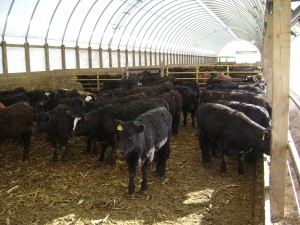All producers whether a feedlot operator or a grain farmer, have a common nemesis, inclement weather, courtesy of Mother Nature. We cannot control it, and in most cases have to scramble to even begin to prepare for an upcoming weather event. The starting of beef calves on feed is no exception. As cattle feeders we have many weather wise tidbits that are passed on by each generation. ‘Wean by the moon’, ‘Cold weather drives calves to the bunk’, ‘a wet calf is a sick calf’, ‘Heat will kill more calves than cold’. We could fill a short book with these tidbits of advice as it relates to cattle management and the weather.
Let’s take a look at weather factors and their impacts on health and performance in the first 30 days on feed for an unweaned calf entering the feed yard. This analysis needs to start with what does and ideal situation in an outside pen look like.
- Dry but not so dry we have dust issues.
- Moderate temperatures without major temperature swings (less than 30 degree swings between daytime highs and nighttime lows).
- No rain, No snow and minimal winds.
These demands do not seem too drastic and SHOULD be relatively easy to achieve. When you figure out how to accurately predict the weather 30 days in advance let me know and we will become millionaires together.
One of the major factors affecting early feedlot performance is intakes. Getting calves to eat consistently in the first 7 days has a huge impact on overall performance and health of any group of calves. This is even more pronounced when dealing with light calves (3-400 lbs.) due to the physical size of the rumen.
Any issue that reduces intakes or increases the maintenance requirement of the calf will put the calf in a negative energy balance (NEB). In a NEB situation the animal’s body begins to scramble to find all available resources and direct it toward energy production. The first place the body robs energy is in from the immune system as proteins used for antibody production are easily redirected with slight increases in cortisol (the bodies stress hormone). This is important for whether the stressor is weaning (pacing, walking, bawling and heightened nervousness caused by unfamiliar surroundings) or weather related, the body reacts similarly.

Weather stresses have a huge impact on this calf at this extremely vulnerable time in the production cycle. Intakes in the first several weeks are barely at a level to support the maintenance requirement of the calf. A mild weather stress (rain at 50°F) will increase the calves’ maintenance requirement by as much as 20% and for every additional 10°F drop in temperature it will increase by another 20%. This is not taking into account the additional stressor of the mud in the yard that this calf is dealing with. Not only will these calves not be gaining any weight but with a suppressed immune system just one or two days under these conditions will cause a severe outbreak of disease.
It is widely accepted that treating a calf just once in the first month will impact significantly the performance of the entire feeding period. Our records at Grand Meadow Feeders show a 100lb/hd advantage on calves that have never been treated as compared to calves treated just once in the first 90 days. The numbers grow from there for calves that need to be treated 2 and 3 times. Groups of calves with high morbidity tend to have higher mortality at closeout even if death rates in the first month of the feeding period are similar. This is a true performance advantage and does not take into account the additional labor to pull and treat an animal.
According to Kansas State University’s Beef Stocker Unit Director Dale Blasi, “One thing we can’t do much about is the weather, and that is a major factor in the wellness of stressed cattle,” he continues, “ If the weather is favorable a set of calves might almost be bullet-proof; but those weather swings can seriously exacerbate sickness.”
Whether your business is starting and finishing calves or you are strictly a backgrounder, don’t let Mother Nature dictate to you the profitability on any set of calves. Take the weather out of the equation with the Hoop Beef System and let your cattle perform to their genetic potential.
We Got Ya Covered….Don’t Track it in the House.
